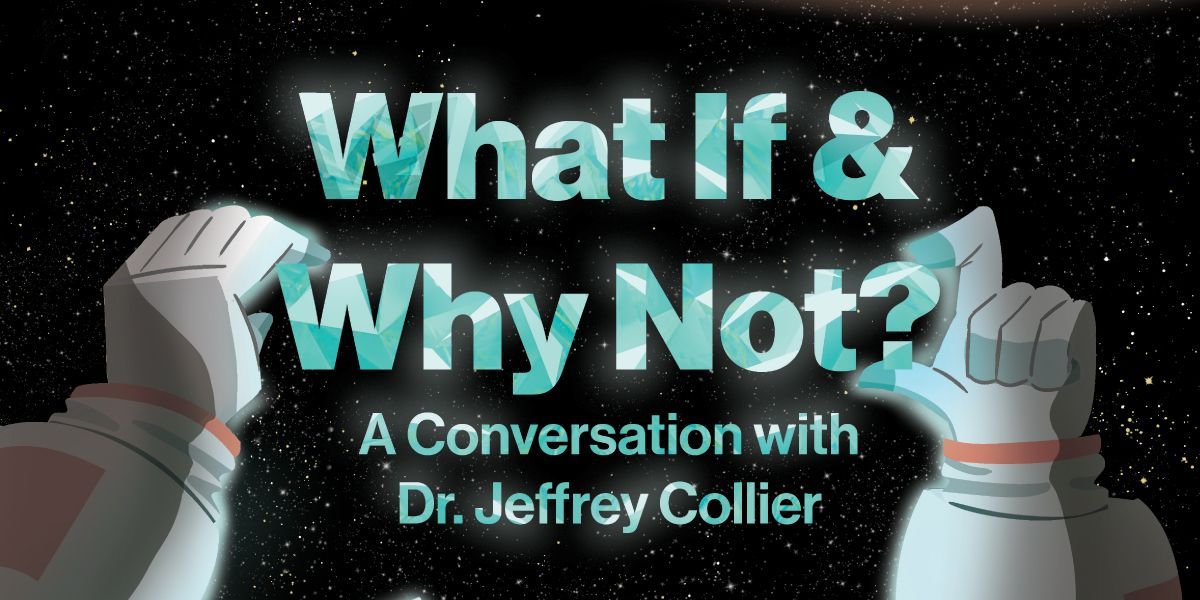Dr. Jeffrey Collier: What If & Why Not?
As Saginaw ISD’s storyteller in chief, Dr. Jeffrey Collier doesn’t shy away from authentic and enthusiastic district communications.


At the time of this interview, Jeffrey Collier, superintendent of Saginaw Intermediate School District in Michigan, had been an Ed.D. for just under 24 hours. Dr. Collier could not stop beaming as he shared the details of his dissertation defense, saying it felt “like the weight of the world” was off his shoulders at last.
Previously the superintendent of Au Gres-Sims School District—a small, rural school system in Michigan—Collier is now at the helm of one of the state’s 56 intermediate school districts. Saginaw ISD serves 12 local districts, five school academies, and 22 non-public schools—totaling around 27,000 students. Collier has strong ties to Saginaw. He attended graduate school there, it’s his wife’s hometown, and he has partnered with school districts in Saginaw throughout his entire career. So when the opportunity arose to move into his current position, he was excited to begin building a new vision throughout Saginaw County.
Leading a small district like Au Gres-Sims and leading Saginaw ISD are vastly different experiences, to say the least. But in both circumstances, Collier has prioritized acting as a servant leader. That means constructing an organizational identity that includes and empowers those around him.
Self-described as progressive and motivated by positivity, Collier has a bit of a reputation for his unique take on school marketing. In fact, a few weeks after we spoke, Collier was recognized as the 2021 Superintendent Communicator of the Year by the Michigan School Public Relations Association. Here, Collier shares with us how he has molded branding and marketing into something authentic, inclusive, and liberated—something that looks like a story.
How have your thoughts on branding changed since joining Saginaw ISD?
It’s important to first understand the differences between where I am now and where I was as a local school leader. When we talk about local school districts, we have to understand that superintendents—as local servants—are the chief stewards of their specific communities. Having priorities beholden to a local community can really affect how a district’s identity is constructed.
Local school leaders have to be cognizant of who and what they serve: the families in their communities as well as the pride and history there. Anytime a school leader talks about their district, they’re advocating for their local community.
But as an ISD superintendent, I now represent a number of different communities. I’m not competing with anyone. I’m not beholden to a mascot; I’m beholden to everybody. That changes my approach to branding because it shifts the conversation toward storytelling.
I’m no longer talking about an advertisement that says, Please move to our community so your children can go to this specific school. Now, I’m talking about broader concepts like what’s best for pedagogy, professionalism, talent attraction, and retention. I’m advocating for all—regardless of any specific brand identity. That’s where my role has changed: It’s less about branding a local district and more about being the storyteller in chief.
Why do you consider storytelling a shared responsibility?
Storytelling means sharing what we do every single day. It’s an opportunity for us to make use of every unique perspective. As we talk about whose job it is to promote the brand, who the leader is, and whose voices should be heard—it really becomes a patchwork quilt. It’s about sharing ownership and asking how to approach that kind of shared narrative.
If you’re a local school leader, think about all the touchpoints that one of your students has with your schools. There’s the bus driver who’s the first to say good morning and the last to say goodnight. There are cafeteria workers, maintenance crews, office secretaries, teachers, and coaches. Every single one of those people has a unique perspective.

When I’m working in the same school as another educator, we’ll both be working toward the same mission: putting kids first. But I’m willing to bet that their style and daily practices are going to be different from mine. Their Aha! moments, interactions with people, the morale they bring into the classroom—all of it’s going to be different. And yet so many districts fail to include that in their stories because they only speak from the standpoint of an organizational mission rather than through individual perspectives.
When you find a way to share all these unique voices within a larger story about culture, climate, and organization, you begin to see the layers of what takes place every day. Storytelling is a shared lift. Sure, I can provide vision and delegate tasks because that’s my job, but if I’m the sole author of our story—well, that’s a pretty thin book.
You sometimes describe good marketing and branding as “byproducts.” What do you mean by that?
The University of Michigan has a pretty iconic logo—a big, yellow block “M.” When they have a football game, people around the state feel an emotional pull to the block “M.” They didn’t necessarily go to the University of Michigan or graduate from there—but there is still this strange connection. When I talk about branding and marketing as the byproduct of a story, I’m talking about how that iconic block “M” logo derives its energy and power from the overall product of the university: the narrative they’ve created for themselves.
So that’s where it starts—with a story. Without a story, we find ourselves in this malaise of incomprehension. Our communities don’t understand who we are. When we don’t capture the story, we aren’t sharing the joy and inspiration of what happens in the classroom every day. You have to focus first on the joy that’s being brought to students.
Ask yourself: What is your district known for? If you can’t answer that question, all you have is a logo and a mascot. But logos and mascots don’t show your community what your teachers do all day. Your teachers may interact with more than a hundred kids, have amazing classroom conversations, and write innovative lesson plans. But unless you tell that story, no one will know. Once you have a rich, enticing story of what you do, good branding and marketing are automatic byproducts.
How can you tell if your stories are impacting your community?
I know a lot of organizations are bound to metrics, to the quantifiable: How many retweets did we get? How many views did we get on Facebook? But we should ask ourselves if these kinds of metrics are meaningful representations of our true work. I would much rather have one person become genuinely attached to our story every single day.
That’s why I’ve focused on what I call the “+1 model”—simply reaching one more person every single day who may not have previously understood who we are. I really believe that if we focus on that, we will make more progress than we would by building a larger but less genuine audience. So while we can use the metrics of social media to understand the reach of our story, the success of a story depends on how genuine it is, on whether or not it hits home. And there aren’t really metrics for that.
One of my mentors used to talk about how you can sense culture. When you walk into a building, you can just tell if it’s welcoming or not. It’s a feeling. You walk in, and you think, Oh. Yes. This place is for me. There’s an energy, a vibe. It’s a very difficult thing to measure. But if the story is right, then the feeling is right. And the more authentic a story is, the more potential you have for that feeling.
Ultimately, it comes down to this: Creating a positive culture moves glacially—one person at a time, one professional at a time, one community member at a time.
What would you say to a school leader who thinks their staff won’t want to participate in storytelling?
Our vision and mission here at Saginaw ISD is three words: Serve. Innovate. Empower. We bring everything back to that focus. Storytelling is about empowering everybody in the district to be an author.
Imagine administration coming through and saying, Hey, I have a great opportunity for you to share your authentic voice and what’s happening in your classroom. I’m going to ask you to share one positive thing a day. That’s it. You’ve worked incredibly hard on lesson plans and put all your energy into these kids, so I’m just asking for one positive thing to share with our community.
The trick is to empower educators first. Give them the choice to be positive, to engage, to be authentic, and to add to your story. By giving them the choice, you’re showing them someone cares about what they’re doing.
So many educators don’t feel appreciated, or they feel like others don’t take notice of what’s happening in their schools. Well, here’s an opportunity to communicate just that! But don’t force it. If they choose to engage, that’s a choice to be positive, to be authentic, and to add to the district’s overall message. If they choose not to engage, is it because they feel like they have nothing positive to share? If that’s the case, then I’d say maybe those are negative voices that don’t belong in your district’s narrative to begin with. Regardless of who chooses to participate, giving your staff the option creates an environment where it’s clear that the community cares about the work they’re doing.
Tell us about your philosophy: What if and why not?
Our what if and why not philosophy was born out of the saying: If not us, then who? If not now, then when? I use this guiding principle to push the boundaries of everybody’s comfort levels. It’s my way of saying that nothing is out of bounds of what we can do.
First, let’s ask: What if? Let’s dream to dream! It’s a progressive and creative opportunity to say everything is acceptable here and all ideas are welcome. What if we make one post a day? What if we share one positive moment a day? What if we convince one more community member to buy into our authentic story every single day?
Of course, there’s another type of what if: What if we don’t share our story? What if we don’t elevate our positive voices? I’ll tell you this: If we aren’t the ones deciding who we are, someone else will decide for us. So, for me, it’s a kind of mantra. It says: Let’s go for it. What if we tell our own story—and why not?

SchoolCEO is free for K-12 school leaders. Subscribe below to stay connected with us!

